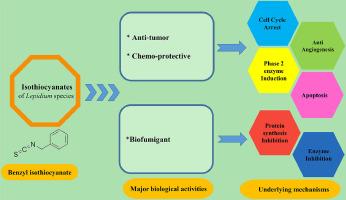The genus Lepidium L. (Brassicaceae), A comprehensive review of botany, traditional uses, pharmacology, phytochemistry and the possible toxicities
IF 4.6
Q2 MATERIALS SCIENCE, BIOMATERIALS
引用次数: 0
Abstract
Lepidium L. an important weedy plant of Brassicaceae family, comprises approximately 265species which are endemic to all continents. Since ancient time, the therapeutic potential of Lepidium species were fully recognized and traditionally used in different parts of the world such as Asian, African and American countries. This review aimed to provide comprehensive information about the botanical characteristics, traditional uses, pharmacology, phytochemistry and toxicology of Lepidium, to discover therapeutic potentials of different Lepidium species for further research. The information available on Lepidium species were collected from scientific databases such as Science Direct, Google Scholar, Scopus, Web of Science, PubMed and some traditional texts. There are several promising bioactivities for this genus that some of them have long been recognized in traditional medicine such as coagulant, biofumigant, hepato-renal protective activities and fertility enhancement. To date, several types of phytochemicals isolated and identified from Lepidium species including glucosinolate, alkaloid, alkamide, macamide, mucilage, phytosterol, flavonoid and essential oil. A significant number of glucosinolates and their hydrolysis products (isothiocyanates), have been isolated from Lepidium species with potential pharmacological activities including anti-carcinogenic and chemoprotective activities with different mechanism of actions. Some studies on the safety assessment of L. sativum L., a common used Lepidium species, indicated some degree of toxicities in animal fetus which supposed to be related to its hydrolysis product constituents, named benzyl isothiocyanates (BITC). Moreover, exposure to goitrin, a glucosinolate degradation product from certain Lepidium species, may exert some adverse effects on thyroid glands, through the competitive inhibition of iodine uptake. It should be notice that despite the beneficial effects of Brassicaceae plants for reducing risk of different types of disease especially cancer, limit of the consumption of some Lepidium species as a routine meal should be considered.

芸苔属植物,植物学、传统用途、药理学、植物化学和可能毒性的全面回顾
莴苣(Lepidium L.)是十字花科(Brassicaceae)的一种重要杂草植物,约有 265 种,是各大洲的特有物种。自古以来,鳞茎类植物的治疗潜力就得到了充分认可,并在世界不同地区(如亚洲、非洲和美洲国家)得到传统使用。本综述旨在提供有关鳞叶属植物的植物学特征、传统用途、药理学、植物化学和毒理学的全面信息,以发现不同鳞叶属植物的治疗潜力,供进一步研究。有关鳞叶属植物的信息来自科学数据库,如 Science Direct、Google Scholar、Scopus、Web of Science、PubMed 和一些传统文献。该属植物有几种很有前景的生物活性,其中一些在传统医学中早已得到认可,如凝结剂、生物熏蒸剂、肝肾保护活性和提高生育能力。迄今为止,已从鳞茎属植物中分离和鉴定出多种植物化学物质,包括葡萄糖苷酸、生物碱、生物酰胺、大酰胺、粘液质、植物甾醇、黄酮类化合物和精油。已从鳞叶草中分离出大量具有潜在药理活性的葡萄糖苷酸盐及其水解产物(异硫氰酸盐),包括具有不同作用机制的抗癌和化学保护活性。一些关于常用鳞茎类植物 L. sativum L. 安全性评估的研究表明,该植物对动物胎儿有一定程度的毒性,这可能与其水解产物成分(异硫氰酸苄酯(BITC))有关。此外,某些鳞茎类植物的葡萄糖苷酸降解产物鹅膏菌素可能会通过竞争性抑制碘吸收而对甲状腺产生不利影响。应该注意的是,尽管十字花科植物对降低各种疾病尤其是癌症的风险有益,但仍应考虑限制将某些鳞叶类植物作为日常膳食食用。
本文章由计算机程序翻译,如有差异,请以英文原文为准。
求助全文
约1分钟内获得全文
求助全文

 求助内容:
求助内容: 应助结果提醒方式:
应助结果提醒方式:


